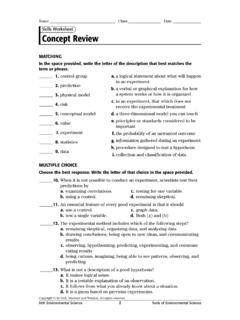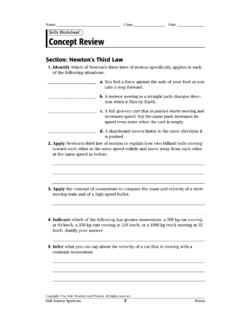Transcription of Skills Worksheet Concept Review
1 Copyright by Holt, Rinehart and Winston. All rights Chemistry28 The Periodic TableSection: Trends in the Periodic TableComplete each statement below by writing the correct word or words in the amount of energy needed to remove an electron from a specific atom iscalled the energy of the is half the distance from center to center oftwo like atoms bonded the energy change that occurs when a neutralatom gains an a numerical value that reflects how much anatom in a molecule attracts the nuclear charge increases across a period, the effective nuclear chargepulling the electrons closer to the nucleus andthe size of the the letter of the choice that best answers the of the following elements has the largest atomic radius? of the following elements has the smallest ionization energy?
2 ReviewSkills WorksheetCopyright by Holt, Rinehart and Winston. All rights Chemistry29 The Periodic TableNameClassDateConcept Review of the following elements has the largest electronegativity? the following questions in the space why the exact size of an atom is difficult to metal has the larger radius, Li or Na? Why? is electron shielding? the large decrease in atomic radii as you move across a period fromGroup 1 to Group why ionization energies tend to decrease down a by Holt, Rinehart and Winston. All rights Chemistry30 The Periodic TableNameClassDateConcept Review the large increase in electronegativity as you move across a the following TrendsFrom left to right across a periodDown a groupIonization energyAtomic radiusElectronegativityIonic sizeElectron affinityConcept Review : Trends inthe Periodic , electron cloud model is based onthe probability of finding an electronat a specific location.
3 As you move far-ther out from the nucleus, the proba-bility of finding electrons becomesless and less. With this model there isnot a well-defined boundary of theindividual ; because it has one more energylevel than shielding is the reduction ofthe attractive force between a posi-tively charged nucleus and its outer-most electrons due to the cancellationof some of the positive charge by thenegative charge of the other the outermost electrons are pulledcloser to the nucleus, they also getcloser to one another and repulsiongets stronger. At Group 13, the elec-trons will not come closer to thenucleus because the electrons repeleach element has one more occupiedenergy levels than the one above , the outermost electrons arefarther from the nucleus as you movedown a group. Also, each successiveelement contains more electronsbetween the nucleus and the outer-most electrons.
4 These innermost elec-trons shield the outermost electronsfrom the full attractive force of thenucleus, thereby making it easier toremove valence you more across a period, eachatom has one more proton and onemore electron in the same principalenergy level as the one before , because electron shieldingdoes not change, the nuclear chargeincreases across a period, attractingthe electrons more TrendAcross aDown aPeriodGroupIonization EnergyincreasesdecreasesAtomic RadiusdecreasesincreasesElectronegativit yincreasesdecreasesIonic SizedecreasesincreasesElectron affinityincreasesdecreasesConcept Review : Where Didthe Elements Come From? , hydrogen, oxygen, nitrogen,phosphorous, and , electrons, protons, , 93 naturally occurring elementsare found on Earth or on stars. Theremaining 20 elements are cannot accelerate particlesfast enough because as the particlesaccelerate, they become more mas-sive, making it increasingly difficult toachieve further synchrotron times its energy pulsesto match the acceleration of theparticle, thereby accelerating particlesto enormous a few atoms are created and theylast for tiny fractions of a by Holt, Rinehart and Winston.
5 All rights Chemistry61 The Periodic TableTEACHER RESOURCE PAGE









